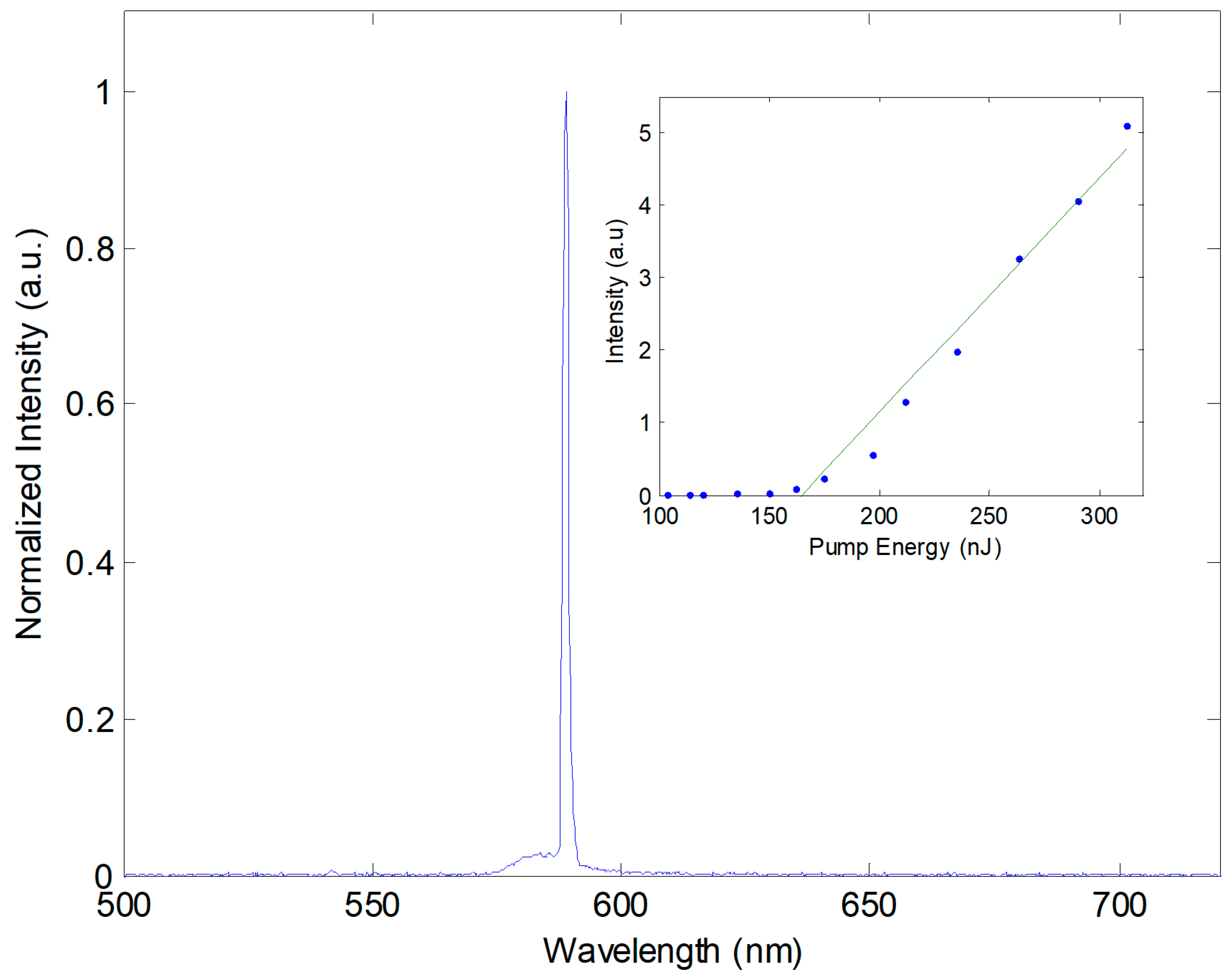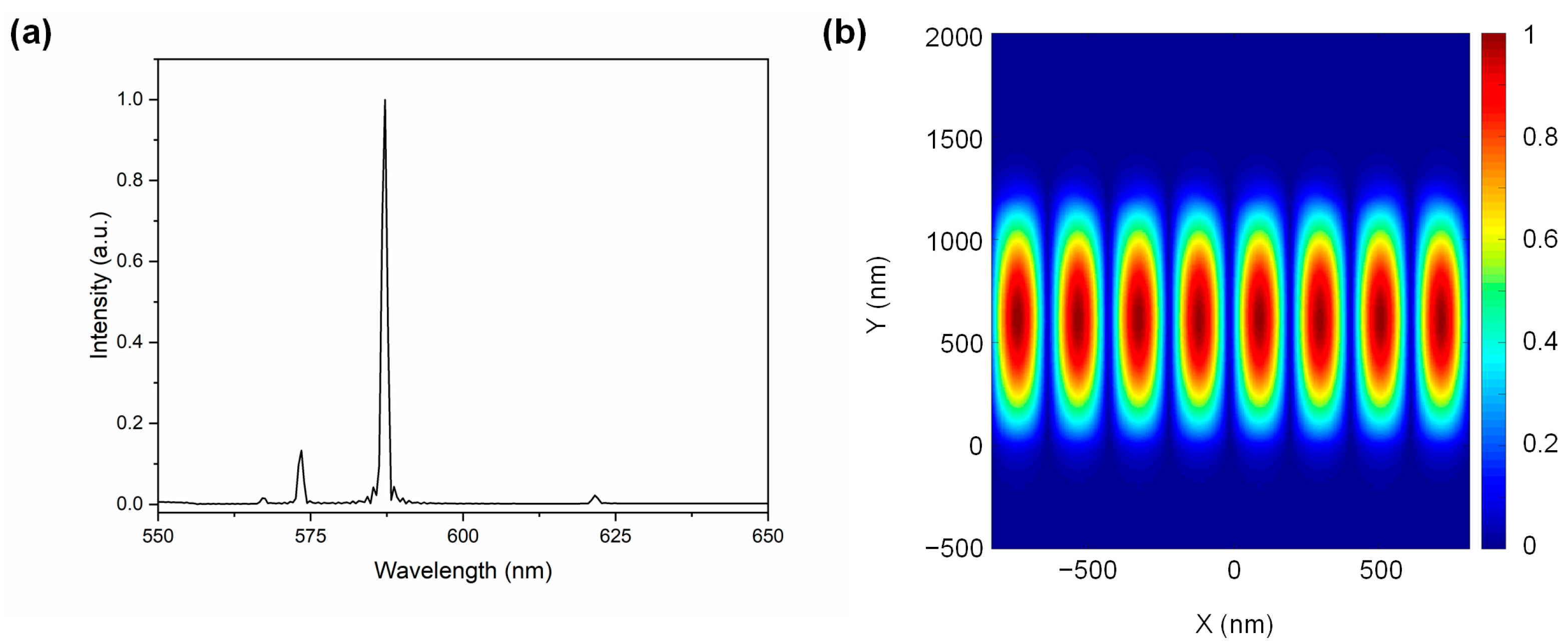Highly Accurate Pneumatically Tunable Optofluidic Distributed Feedback Dye Lasers
Abstract
:1. Introduction
2. Materials and Methods
2.1. Device Design
2.2. Fabrication
2.3. Device Operation
3. Results and Discussion
3.1. Laser Characterization
3.2. Simulation Using FDTD Method
3.3. Laser Wavelength Tuning
4. Conclusions
Supplementary Materials
Author Contributions
Funding
Data Availability Statement
Conflicts of Interest
References
- Lv, C.; Xia, H.; Guan, W.; Sun, Y.-L.; Tian, Z.-N.; Jiang, T.; Wang, Y.-S.; Zhang, Y.-L.; Chen, Q.-D.; Ariga, K. Integrated optofluidic-microfluidic twin channels: Toward diverse application of lab-on-a-chip systems. Sci. Rep. 2016, 6, 19801. [Google Scholar] [CrossRef] [PubMed]
- Hunt, H.C.; Wilkinson, J.S. Optofluidic integration for microanalysis. Microfluid. Nanofluid. 2008, 4, 53–79. [Google Scholar] [CrossRef] [PubMed]
- Fan, X.; White, I.M. Optofluidic microsystems for chemical and biological analysis. Nat. Photonics 2011, 5, 591–597. [Google Scholar] [CrossRef] [PubMed]
- Zhao, Y.; Stratton, Z.S.; Guo, F.; Lapsley, M.I.; Chan, C.Y.; Lin, S.C.; Huang, T.J. Optofluidic imaging: Now and beyond. Lab Chip 2013, 13, 17–24. [Google Scholar] [CrossRef] [PubMed]
- Feng, H.; Shu, W.; Chen, X.; Zhang, Y.; Lu, Y.; Wang, L.; Chen, Y. Development of a microfluidic platform with integrated power splitting waveguides for optogenetic neural cell stimulation. Biomed. Microdevices 2015, 17, 101. [Google Scholar] [CrossRef] [PubMed]
- Mishra, K.; Van den Ende, D.; Mugele, F. Recent developments in optofluidic lens technology. Micromachines 2016, 7, 102. [Google Scholar] [CrossRef] [PubMed]
- Storti, F.; Bonfadini, S.; Criante, L. Battery-free fully integrated microfluidic light source for portable lab-on-a-chip applications. Sci. Rep. 2020, 10, 12910. [Google Scholar] [CrossRef]
- Chen, Y.F.; Jiang, L.; Mancuso, M.; Jain, A.; Oncescu, V.; Erickson, D. Optofluidic opportunities in global health, food, water and energy. Nanoscale 2012, 4, 4839–4857. [Google Scholar] [CrossRef]
- Zaman, M.A.; Hesselink, L. Dynamically controllable plasmonic tweezers using C-shaped nano-engravings. Appl. Phys. Lett. 2022, 121, 181108. [Google Scholar] [CrossRef]
- Lopez, G.A.; Estevez, M.C.; Soler, M.; Lechuga, L.M. Recent advances in nanoplasmonic biosensors: Applications and lab-on-a-chip integration. Nanophotonics 2017, 6, 123–136. [Google Scholar] [CrossRef]
- Huang, L.; Maerkl, S.J.; Martin, O.J.F. Integration of plasmonic trapping in a microfluidic environment. Opt. Express 2009, 17, 6018–6024. [Google Scholar] [CrossRef] [PubMed]
- Sano, T.; Zhang, H.; Losakul, R.; Schmidt, H. All-in-One Optofluidic Chip for Molecular Biosensing Assays. Biosensors 2022, 12, 501. [Google Scholar] [CrossRef] [PubMed]
- Zhang, H.; Zhang, Y.-n.; Li, L.; Hu, J.; Li, X.; Zhao, Y. Optofluidic Lasers and Their Applications in Biochemical Sensing. Lab Chip 2023, 23, 2959–2989. [Google Scholar] [CrossRef] [PubMed]
- Feng, Z.; Bai, L. Advances of Optofluidic Microcavities for Microlasers and Biosensors. Micromachines 2018, 9, 122. [Google Scholar] [CrossRef] [PubMed]
- Vannahme, C.; Maier-Flaig, F.; Lemmer, U.; Kristensen, A. Single-mode biological distributed feedback laser. Lab Chip 2013, 13, 2675–2678. [Google Scholar] [CrossRef] [PubMed]
- Che, K.J.; Yang, Y.J.; Lin, Y.L.; Shan, Y.W.; Ge, Y.H.; Li, S.S.; Chen, L.J.; Yang, C.J. Microfluidic generation of cholesteric liquid crystal droplets with an integrative cavity for dual-gain and controllable lasing. Lab Chip 2019, 19, 3116–3122. [Google Scholar] [CrossRef]
- Jung, H.; Min, K.; Jeon, H.; Kim, S. Physically Transient Distributed Feedback Laser Using Optically Activated Silk Bio-Ink. Adv. Opt. Mater. 2016, 4, 1738–1743. [Google Scholar] [CrossRef]
- Lee, W.; Luo, Y.; Zhu, Q.; Fan, X. Versatile optofluidic ring resonator lasers based on microdroplets. Opt. Express 2011, 19, 19668–19674. [Google Scholar] [CrossRef]
- Li, Z.L.; Zhou, W.Y.; Luo, M.M.; Liu, Y.G.; Tian, J.G. Tunable optofluidic microring laser based on a tapered hollow core microstructured optical fiber. Opt. Express 2015, 23, 10413–10420. [Google Scholar] [CrossRef]
- Tan, Y.F.; Ge, C.; Chu, A.; Lu, M.; Goldshlag, W.; Huang, C.S.; Pokhriyal, A.; George, S.; Cunningham, B.T. Plastic-Based Distributed Feedback Laser Biosensors in Microplate Format. IEEE Sens. J. 2012, 12, 1174–1180. [Google Scholar] [CrossRef]
- Chen, Q.; Ritt, M.; Sivaramakrishnan, S.; Sun, Y.; Fan, X. Optofluidic lasers with a single molecular layer of gain. Lab Chip 2014, 14, 4590–4595. [Google Scholar] [CrossRef] [PubMed]
- Chen, Y.-C.; Chen, Q.; Fan, X. Optofluidic chlorophyll lasers. Lab Chip 2016, 16, 2228–2235. [Google Scholar] [CrossRef] [PubMed]
- Gong, C.; Gong, Y.; Zhao, X.; Luo, Y.; Chen, Q.; Tan, X.; Wu, Y.; Fan, X.; Peng, G.D.; Rao, Y.J. Distributed fibre optofluidic laser for chip-scale arrayed biochemical sensing. Lab Chip 2018, 18, 2741–2748. [Google Scholar] [CrossRef] [PubMed]
- Gauri, B.; Elaine, N.; Youngkyu, L.; John, X.J.Z. Micro-Patterned Quantum Dots Excitation for Cellular Microarray Imaging. In Bioinspired, Biointegrated, Bioengineered Photonic Devices III; SPIE: Bellingham, WA, USA, 2015; p. 93410F. [Google Scholar]
- Feng, H.; Shu, W.; Xu, H.; Zhang, B.; Huang, B.; Wang, J.; Jin, W.; Chen, Y. Two-Directional Tuning of Distributed Feedback Film Dye Laser Devices. Micromachines 2017, 8, 362. [Google Scholar] [CrossRef] [PubMed]
- Rankin, B.R.; Kellner, R.R.; Hell, S.W. Stimulated-emission-depletion microscopy with a multicolor stimulated-Raman-scattering light source. Opt. Lett. 2008, 33, 2491–2493. [Google Scholar] [CrossRef] [PubMed]
- Dubey, V.; Singh, G.; Singh, V.; Ahmad, A.; Mehta, D.S. Multispectral quantitative phase imaging of human red blood cells using inexpensive narrowband multicolor LEDs. Appl. Opt. 2016, 55, 2521–2525. [Google Scholar] [CrossRef]
- Song, W.; Vasdekis, A.E.; Psaltis, D. Elastomer based tunable optofluidic devices. Lab Chip 2012, 12, 3590–3597. [Google Scholar] [CrossRef]
- Cai, Z.; Shen, Z.; Liu, H.; Yue, H.; Zou, Y.; Chen, X. On-chip tunable optofluidic dye laser. Opt. Eng. 2016, 55, 116117. [Google Scholar] [CrossRef]
- Gersborg-Hansen, M.; Kristensen, A. Tunability of optofluidic distributed feedback dye lasers. Opt. Express 2007, 15, 137–142. [Google Scholar] [CrossRef]
- Li, Z.Y.; Zhang, Z.Y.; Emery, T.; Scherer, A.; Psaltis, D. Tunable optofluidic distributed feedback dye lasers. Proc. Soc. Photo-Opt. 2006, 6329, U20–U27. [Google Scholar]
- Li, Z.Y.; Psaltis, D. Optofluidic distributed feedback dye lasers. IEEE J. Sel. Top. Quant. 2007, 13, 185–193. [Google Scholar] [CrossRef]
- Becker, H.; Song, W.; Wang, W.; Psaltis, D. Pressure Mediated Tunable Elastomeric Optofluidic Devices. In Microfluidics, BioMEMS, and Medical Microsystems VIII; SPIE: Bellingham, WA, USA, 2010; p. 759309. [Google Scholar]
- Wang, H.; Vu, S.; Pignanelli, J.; Abdel Fatah, T.; Trant, J.F.; Mahshid, S.; Rondeau-Gagné, S.; Ahamed, M.J. Fabrication and Characterization of Autonomously Self-Healable and Stretchable Soft Microfluidics. Adv. Sustain. Syst. 2022, 6, 2100074. [Google Scholar] [CrossRef]
- Liu, Y.; Yang, T.; Zhang, Y.; Qu, G.; Wei, S.; Liu, Z.; Kong, T. Ultrastretchable and wireless bioelectronics based on all-hydrogel microfluidics. Adv. Mater. 2019, 31, 1902783. [Google Scholar] [CrossRef] [PubMed]
- Fallahi, H.; Yadav, S.; Phan, H.-P.; Ta, H.; Zhang, J.; Nguyen, N.-T. Size-tuneable isolation of cancer cells using stretchable inertial microfluidics. Lab Chip 2021, 21, 2008–2018. [Google Scholar] [CrossRef] [PubMed]
- Fallahi, H.; Zhang, J.; Nicholls, J.; Phan, H.-P.; Nguyen, N.-T. Stretchable Inertial Microfluidic Device for Tunable Particle Separation. Anal. Chem. 2020, 92, 12473–12480. [Google Scholar] [CrossRef] [PubMed]
- Beech, J.P.; Tegenfeldt, J.O. Tuneable separation in elastomeric microfluidics devices. Lab Chip 2008, 8, 657–659. [Google Scholar] [CrossRef] [PubMed]
- Huh, D.; Matthews, B.D.; Mammoto, A.; Montoya-Zavala, M.; Hsin, H.Y.; Ingber, D.E. Reconstituting organ-level lung functions on a chip. Science 2010, 328, 1662–1668. [Google Scholar] [CrossRef]
- Kim, H.J.; Huh, D.; Hamilton, G.; Ingber, D.E. Human gut-on-a-chip inhabited by microbial flora that experiences intestinal peristalsis-like motions and flow. Lab Chip 2012, 12, 2165–2174. [Google Scholar] [CrossRef]
- Zheng, W.; Jiang, B.; Wang, D.; Zhang, W.; Wang, Z.; Jiang, X. A microfluidic flow-stretch chip for investigating blood vessel biomechanics. Lab Chip 2012, 12, 3441–3450. [Google Scholar] [CrossRef]
- Fei, P.; Chen, Z.; Men, Y.; Li, A.; Shen, Y.; Huang, Y. A compact optofluidic cytometer with integrated liquid-core/PDMS-cladding waveguides. Lab Chip 2012, 12, 3700–3706. [Google Scholar] [CrossRef]
- Song, W.; Vasdekis, A.E.; Li, Z.; Psaltis, D. Low-order distributed feedback optofluidic dye laser with reduced threshold. Appl. Phys. Lett. 2009, 94, 051117. [Google Scholar] [CrossRef]





Disclaimer/Publisher’s Note: The statements, opinions and data contained in all publications are solely those of the individual author(s) and contributor(s) and not of MDPI and/or the editor(s). MDPI and/or the editor(s) disclaim responsibility for any injury to people or property resulting from any ideas, methods, instructions or products referred to in the content. |
© 2023 by the authors. Licensee MDPI, Basel, Switzerland. This article is an open access article distributed under the terms and conditions of the Creative Commons Attribution (CC BY) license (https://creativecommons.org/licenses/by/4.0/).
Share and Cite
Feng, H.; Zhang, J.; Shu, W.; Bai, X.; Song, L.; Chen, Y. Highly Accurate Pneumatically Tunable Optofluidic Distributed Feedback Dye Lasers. Micromachines 2024, 15, 68. https://doi.org/10.3390/mi15010068
Feng H, Zhang J, Shu W, Bai X, Song L, Chen Y. Highly Accurate Pneumatically Tunable Optofluidic Distributed Feedback Dye Lasers. Micromachines. 2024; 15(1):68. https://doi.org/10.3390/mi15010068
Chicago/Turabian StyleFeng, Hongtao, Jiaxin Zhang, Weiliang Shu, Xiaosong Bai, Liang Song, and Yan Chen. 2024. "Highly Accurate Pneumatically Tunable Optofluidic Distributed Feedback Dye Lasers" Micromachines 15, no. 1: 68. https://doi.org/10.3390/mi15010068
APA StyleFeng, H., Zhang, J., Shu, W., Bai, X., Song, L., & Chen, Y. (2024). Highly Accurate Pneumatically Tunable Optofluidic Distributed Feedback Dye Lasers. Micromachines, 15(1), 68. https://doi.org/10.3390/mi15010068





